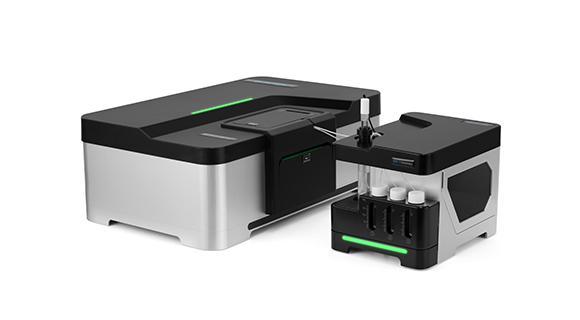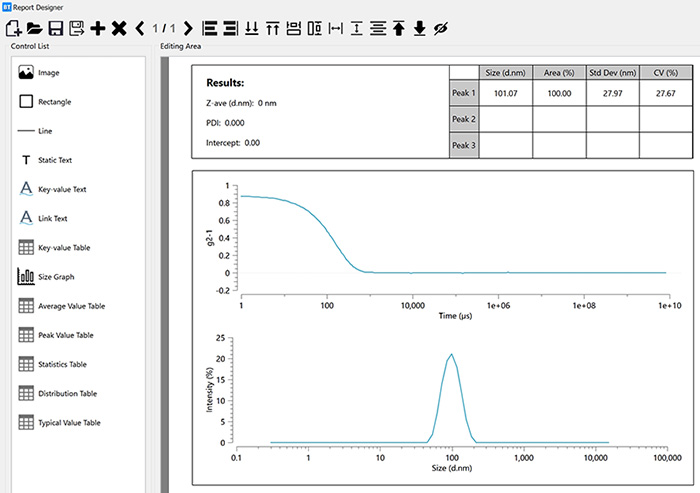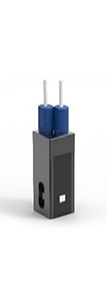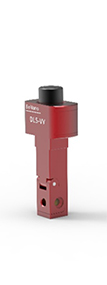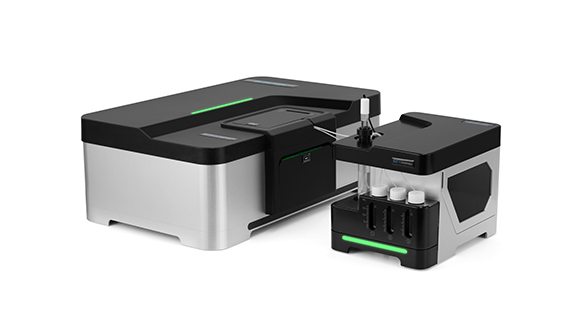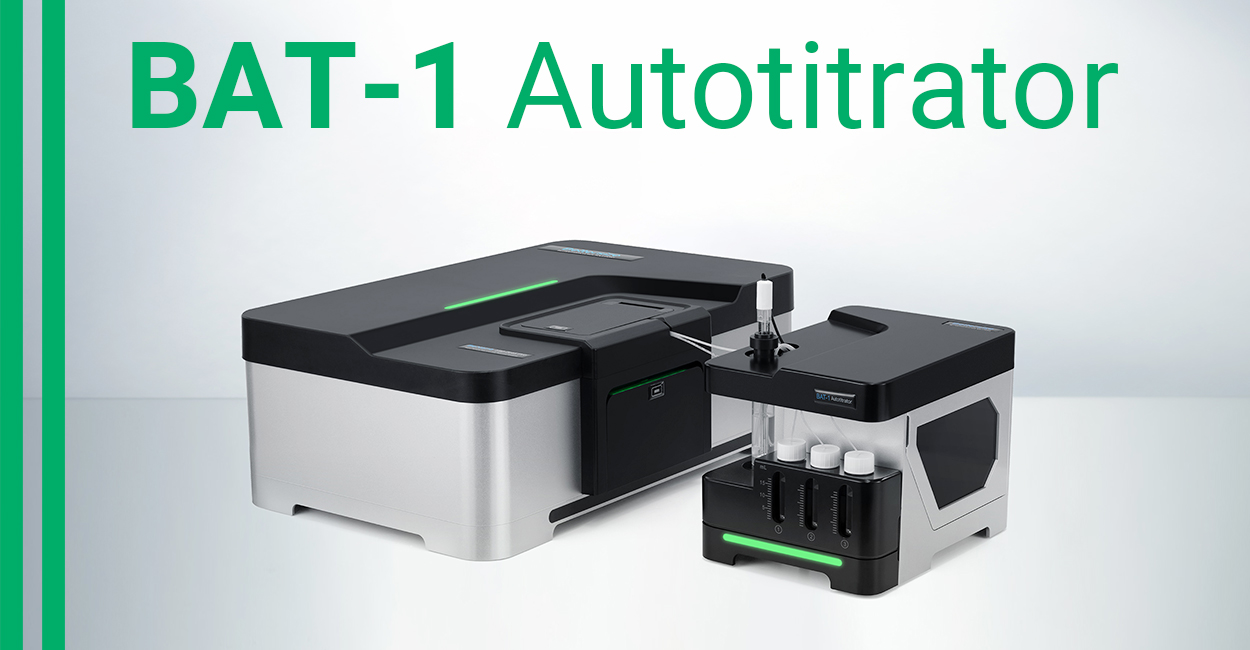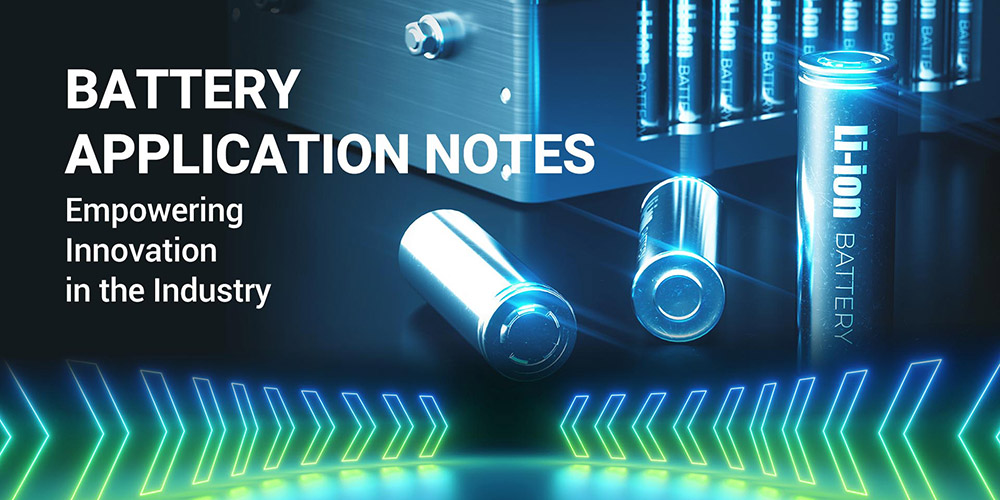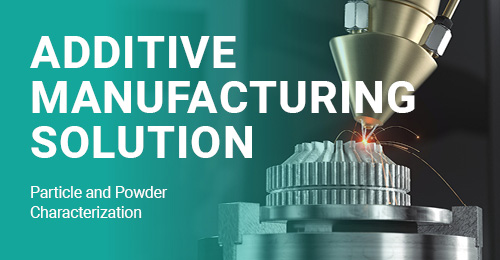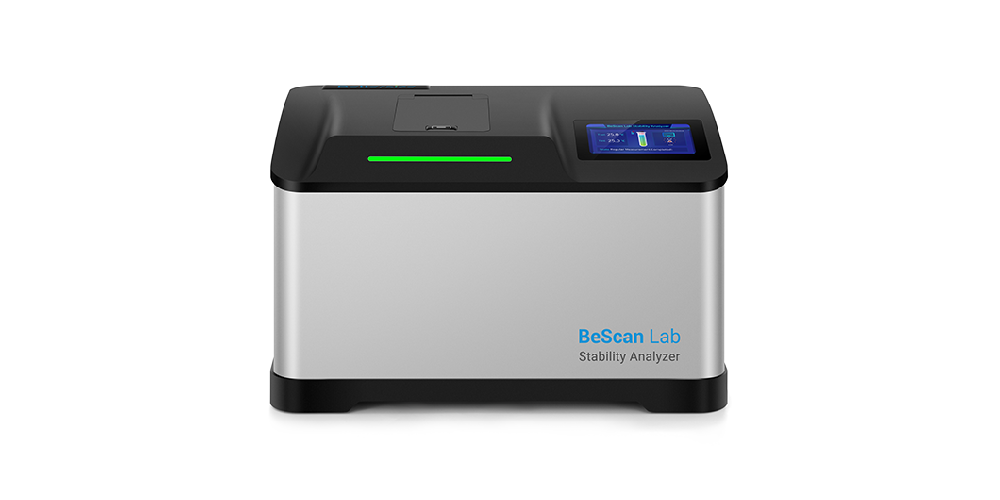BeNano 시리즈는 베터사이즈 인스트루먼트에서 설계한 최신 나노 입자 크기 및 제타 전위 분석기입니다. 동적 광 산란(DLS), 전기 영동 광 산란(ELS) 및 정적 광 산란(SLS)이 시스템에 통합되어 입자 크기, 제타 전위 및 분자량을 정확하게 측정할 수 있습니다. BeNano 시리즈는 화학 공학, 제약, 식음료, 잉크 및 안료, 생명 과학 등 다양한 분야의 학술 및 제조 공정에 널리 적용됩니다.
특징 및 장점
- ● 크기 범위: 0.3nm - 15μm
- ● 최소 샘플 용량: 3μL
- ● 탁월한 감도를 제공하는 APD(아발란치 포토다이오드) 검출기
- ● 레이저 강도 자동 조절
- ● 결과 평가의 지능형 알고리즘
- ● DLS 후방 산란(173°) 감지 기술
- ● 농축 시료를 위한 사용자 조정 가능한 산란량
- ● PALS(위상 분석 광 산란) 기술
- ● 프로그래밍 가능한 온도 제어 시스템
- ● 21 CFR Part 11, ISO 22412, ISO 13099 준수
동영상
Enhanced Size Resolution with DLS Flow Mode 
BeNano 90 Zeta | Demo (Polystyrene Standard Sample) 
Fundamentals of BeNano 90 Zeta 
BeNano 90 Zeta | Nanoparticle size and zeta potential analyzer 
BeNano Series | Customer Perspective & Demo 
Understanding the DLS Backscattering Technology 
Book a Free Demo with Global Distributors 
BeNano 180 Zeta Pro | Demo (Polystyrene Latex Sample) 
BeNano 180 Zeta Pro | Nanoparticle size and zeta potential analyzer 
BeNano 180 Zeta Pro Launch Event | Nanoparticle size and zeta potential analyzer 
4 Questions Nanoparticle Researchers are Really Asking About 
Fundamentals of BeNano 180 Zeta Pro 
Fundamentals of BAT 1 Autotitrator 
Fundamentals of DLS Microrheology 
How to Measure Microrheological Properties of Liquids by BeNano? 
How to Operate BAT 1 Autotitrator to Measure Zeta Potential vs. pH 
Fundamentals of BeNano 180 Zeta Pro 
개요
BeNano로 더 큰 연구 잠재력 활용하기
- 고급 ELS 기술: PALS
PALS 기술은 등전점에 가깝거나 염분이 높은 환경에서 전기영동 이동도가 약한 시료의 경우에도 전기영동 거동을 효과적으로 구분하고 추출할 수 있습니다.
- 고급 DLS 기술: 후방 산란 검출
후방 산란 DLS 광학은 90도 광학에 비해 훨씬 더 큰 산란량을 감지할 수 있습니다. 이동식 측정 위치와 결합된 후방 산란 DLS는 훨씬 더 높은 감도와 높은 탁도 시료 측정 용량을 제공합니다.
- 온도 추세 측정
열에 민감한 시료의 경우 프로그래밍된 SOP를 통해 온도 추세를 쉽게 수행할 수 있습니다. BeNano는 단백질 시료의 응집 온도인 크기 결과의 온도 전이점을 감지할 수 있습니다.
- 안정적이고 내구성이 뛰어난 광학 벤치
BeNano는 50mW 고체 레이저, 단일 모드 광섬유 시스템 및 고성능 APD 검출기를 채택하여 안정적이고 광범위하며 고도로 중복된 검출 기능을 제공합니다.
- 연구 수준 소프트웨어
BeNano 소프트웨어는 산란광 신호를 지능적으로 평가하고 처리하여 신호 품질과 결과 안정성을 향상시킬 수 있습니다. 내장된 다양한 계산 모드를 통해 여러 과학 연구 및 응용 분야를 다룰 수 있습니다.
- 매우 적은 시료량 필요
제약 산업 및 학계의 초기 단계 R&D에는 미량의 시료 측정이 필요합니다. 모세관 사이징 셀을 사용하면 3~5μL의 시료만 있으면 정밀한 크기 측정이 가능합니다.
| 모델 | 기술 | 주요 기능 | |||||
| 90° DLS & SLS | 173° DLS & SLS | 12° ELS & PALS | 입자 크기 | 제타 전위 | 분자량 | 유변학적 특성 | |
| BeNano 180 제타 프로 | √ | √ | √ | √ | √ | √ | √ |
| BeNano 180 제타 | √ | √ | √ | √ | √ | √ | |
| BeNano 90 제타 | √ | √ | √ | √ | √ | √ | |
| BeNano Zeta | √ | √ | |||||
| BeNano 180 Pro | √ | √ | √ | √ | √ | ||
| BeNano 180 | √ | √ | √ | √ | |||
| BeNano 90 | √ | √ | √ | √ | |||
1. 동적 광 산란(DLS)으로 측정한 입자 크기
광자 상관 분광법(PCS) 또는 준탄성 광 산란(QELS)이라고도 하는동적 광 산란 (DLS)은 분산제에서 브라운 운동을 측정하는 데 사용되는 기술입니다. 작은 입자는 더 빨리 움직이고 큰 입자는 더 느리게 움직인다는 원리를 기반으로 합니다. 입자의 산란 강도는 애벌런치 포토다이오드(APD)로 감지한 다음 상관분석기를 사용하여 상관 함수로 변환합니다. 이 상관 함수에서 수학적 알고리즘을 적용하여 확산 계수(D)를 구할 수 있습니다. 유체역학적 직경(DH)과 그 분포는 확산 계수를 입자 크기와 연관시키는 스토크스-아인슈타인 방정식을 사용하여 계산할 수 있습니다.
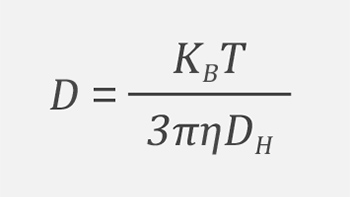

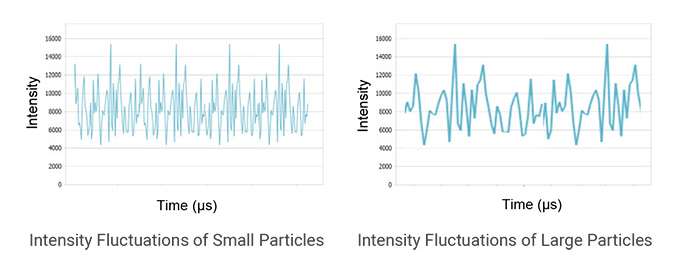
2. 후방 산란 감지 기술
특징
- 더 넓은 농도 범위
검출 위치를 최적화하여 시료 셀의 가장자리 근처에서 고농도 시료를 검출할 수 있어 다중 광산란 효과를 효과적으로 최소화합니다.
- 더 높은 감도
기존 90° 광학 설계에 비해 산란량은 8~10배, 감도는 약 10배 높습니다.
- 더 높은 크기 상한
큰 입자의 다중 빛 산란을 완화하고 훨씬 더 큰 산란 부피로 인해 큰 입자의 수 변동을 어느 정도 줄입니다.
- 재현성 향상
DLS 후방 산란 기술은 먼지 오염 물질과 고르지 않게 분포된 응집체의 영향을 덜 받으며 더 나은 재현성을 제공합니다.
최적의 감지 위치를 위한 지능형 검색
- 소프트웨어는 시료의 크기, 농도, 산란 능력에 따라 최적의 검출 위치를 자동으로 결정하여 최고의 측정 정확도를 달성하고 다양한 유형과 농도의 시료를 유연하게 검출할 수 있습니다. 이 기능은 각각 고유한 산란 특성과 농도를 가진 다양한 시료를 다룰 때 특히 유용합니다.

(1) 시료 셀 중앙의 검출 지점
산란량이 많아 기기 감도를 높이고 산란 효과가 약한 희석 시료를 검출하는 데 적합합니다.
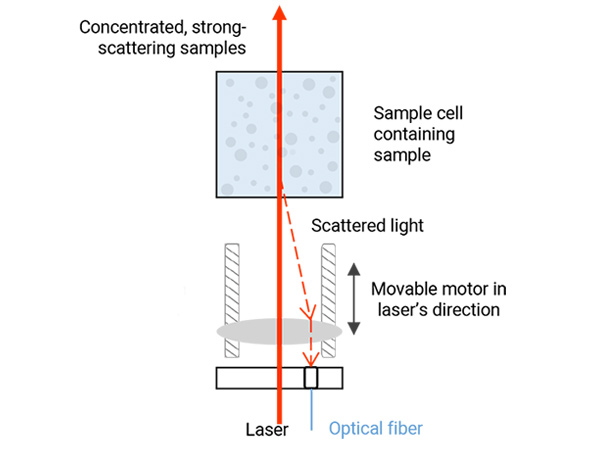
(2) 샘플 셀 가장자리에 있는 검출 지점
고농도 시료의 다중 산란 효과를 방지하여 정확하고 반복 가능한 입자 크기 결과를 보장합니다.
3. DLS 흐름 모드
DLS 흐름 모드는 복잡한 다분산 시스템의 고해상도 크기 결과를 제공합니다. GPC/SEC 또는 FFF와 같은 프런트엔드 분리 장비와 결합하면 입자가 단분산 분획으로 분리되어 크기별로 순차적으로 BeNano를 통과합니다. 각 분획의 크기는 연속적으로 측정되어 고해상도 크기 분포로 합산됩니다.
BeNano는 RI 또는 UV 신호를 획득할 수 있어 배치 모드 측정에 비해 알고리즘에 관계없이 보다 정확한 부피 및 개수 분포를 제공합니다.

입자 특성 분석을 위한 BeNano와 SEC의 통합 사용
응용 분야
- 미립자 및 폴리머의 크기와 분산도에 대한 특성 분석
- 단백질의 단량체, 이합체 및 응집체 구별
크기, 강도 및 굴절률(RI)의 유출물 곡선
 검은색 곡선: 배치 모드를 사용한 BSA 크기 분포
검은색 곡선: 배치 모드를 사용한 BSA 크기 분포
빨간색 히스토그램: 흐름 모드에서의 BSA 크기 분포
흐름 모드는 배치 모드에 비해 BSA 분자의 크기와 분산도에 대한 보다 정밀한 정보를 제공합니다.
4. 고해상도 크기 측정
특징
- GPC/SEC, FFF 등과 연결되는 DLS 분석기.
- RI, UV 또는 기타 검출기로부터 최대 3개의 신호 수신
- 대역 확장을 방지하는 27uL 저용량 플로우 셀
- 1.3의 높은 크기 분해능: 1
- 강도 외에 수와 부피에 따라 가중치가 부여된 크기 분포
- 단백질, 폴리머 등과 같은 복잡한 다분산 시스템에 적합합니다.
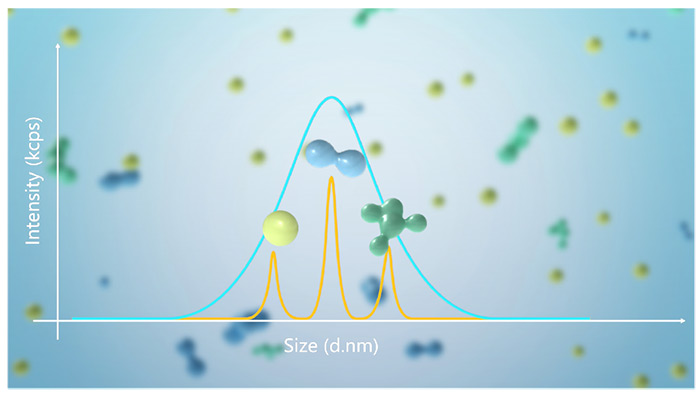
흐름 모드를 통해 고해상도 크기 분포 달성
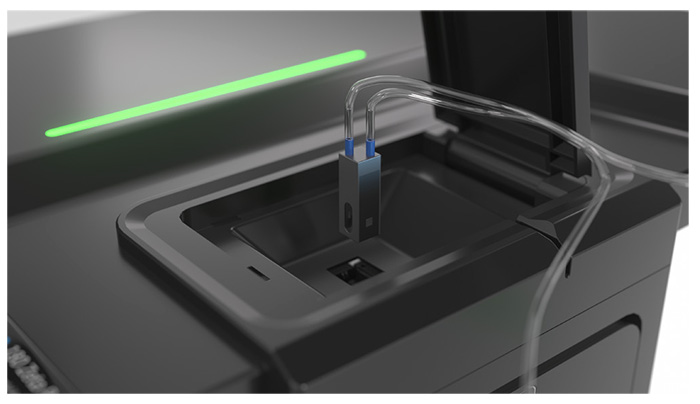
측정하는 동안 입자는 유동 상태로 유지됩니다.

크기 분리 후 입자 검출
5. 전기영동 광 산란(ELS)으로 측정한 제타 전위
수성 시스템에서 하전 입자는 내부 스턴 층과 외부 전단 층을 형성하는 반대에 의해 둘러싸여 있습니다. 제타 전위는 전단 층의 계면에서의 전기 전위입니다. 제타 전위가 높을수록 서스펜션 시스템의 안정성이 높고 응집이 적다는 것을 나타냅니다. 전기영동 광 산란(ELS)은 산란된 빛의 도플러 이동을 통해 전기영동 이동성을 측정하며, 헨리 방정식으로 시료의 제타 전위를 결정하는 데 사용할 수 있습니다.
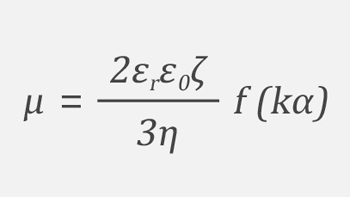
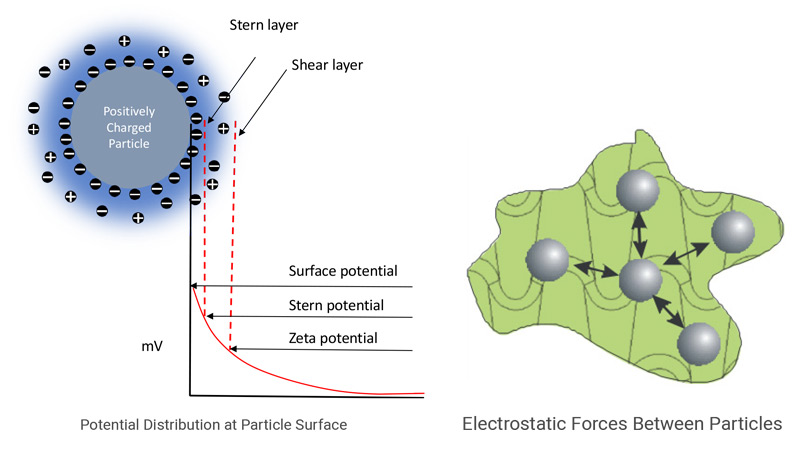


6. 위상 분석 광 산란(PALS)
위상 분석 광 산란(PALS)은 전통적인 ELS 기술을 기반으로 하는 고급 기술로, 베터사이즈가 시료의 제타 전위와 그 분포를 측정하기 위해 더욱 발전시킨 기술입니다.
특징 및 이점
- 전기영동 이동도가 낮은 시료의 정확한 측정
- 유전율이 낮은 유기 용매의 시료에 효과적임
- 전도도가 높은 시료에 대한 보다 정확한 결과
- 전하가 등전점에 근접한 입자의 제타 전위를 효과적으로 측정합니다.


7. 정적 광 산란
정적 광 산란(SLS)은 레이리 방정식을 통해 시료의 산란 강도, 무게 평균 분자량(Mw), 2차 바이럴 계수(A2)를 측정하는 기술입니다:

여기서 c는 시료 농도, θ는 검출 각도, Rθ는 각도 θ에서 산란광과 입사광 사이의 강도 비율을 특성화하는 데 사용되는 레이리 비율 , Mw는 시료의 무게 평균 분자량, A2는 두 번째 바이럴 계수, K는 (dn/dc)2와 관련된 상수입니다.
분자량을 측정하는 동안 다양한 농도에서 시료의 산란 강도가 감지됩니다. 알려진 표준(예: 톨루엔)의 산란 강도와 레이리 비율을 사용하여 다양한 농도의 시료의 레이리 비율을 계산하고 데비 플롯에 플롯합니다. 그런 다음 분자량과 두 번째 바이러스 계수는 Debye 플롯의 선형 회귀에서 절편과 기울기를 통해 얻습니다.
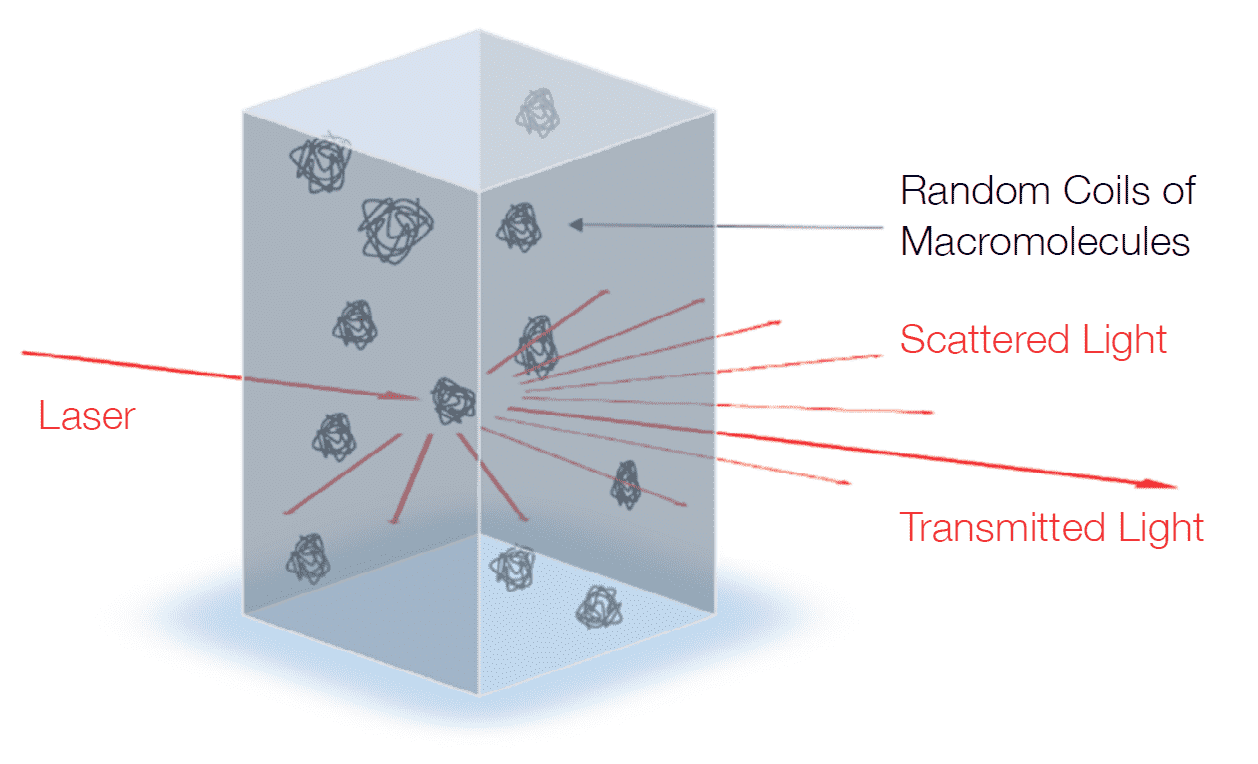
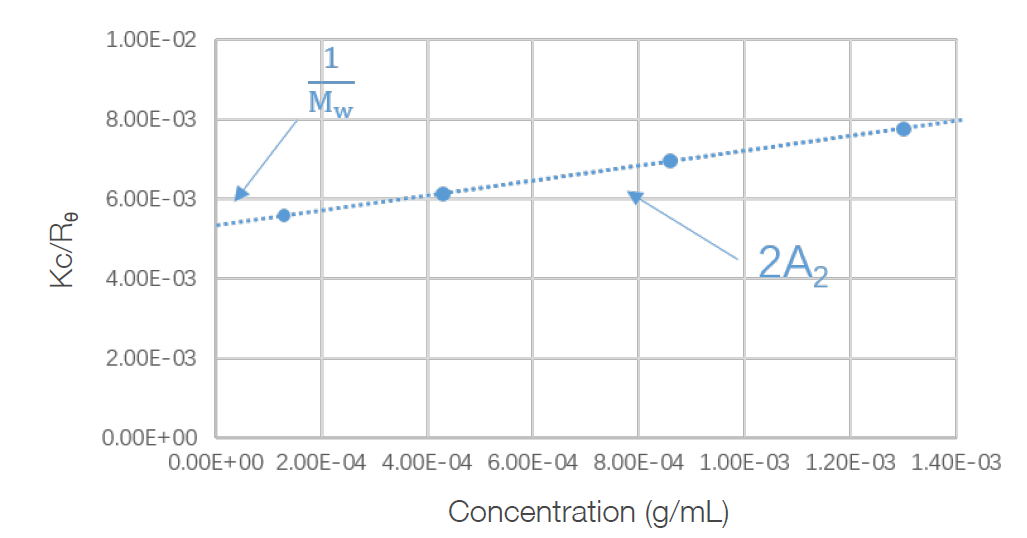
8. DLS로 측정한 미세 조직학
동적 광 산란 미세 유변학(DLS 미세 유변학)은 동적 광 산란을 활용하여 유변학적 특성을 결정하는 경제적이고 효율적인 기술입니다. 콜로이드 추적 입자의 브라운 운동을 분석하여 점탄성 계수, 복소점도 및 크리프 순응도와 같은 시스템의 점탄성 특성에 대한 정보를 일반화된 스토크스-아인슈타인 방정식을 통해 얻을 수 있습니다.

기능 및 이점
- 연구 중인 물질 내에서 추적 입자의 열 구동 운동을 측정하여 유변학적 거동을 조사합니다.
- 광범위한 주파수에서 측정이 용이합니다.
- 추적 입자에 낮은 응력 적용
- 마이크로리터 규모의 시료만 필요합니다.
- 기계적 유변학 결과 보완
- 약한 구조의 시료에 적합
9. 온도 추세 측정
측정 파라미터
- 크기 대 온도
- 제타 전위 대 온도
특징
- 베네핏 단백질 제형 안정성 연구
- 고온 시뮬레이션을 통한 실시간 노화 가속화
이점
- 손쉬운 단백질 제형 안정성 검사
- 고온 시뮬레이션을 통한 실시간 노화 가속화

10. pH 추세 측정
측정 파라미터
- 제타 전위 대 pH
- 등전위
- 전도도 대 pH
특징
- 고정밀 삼원 적정 펌프
- 높은 유량과 높은 유속의 제어 가능한 연동 펌프
- 범용 전극
- 지능형 소프트웨어를 사용하여 초기 및 목표 pH에 따른 자동 적정제 선택
이점
- 더 짧은 시간 내에 측정 완료
- 결과의 일관성 및 반복성 향상
- 연구원의 업무량 감소
- 운영자에게 필요한 자격 요건 간소화
- 고온 시뮬레이션을 통한 실시간 에이징 가속화
- 부식성 액체에 대한 노출 감소

Citations
- Bettersizer 2600
Functional redundancy as an indicator for evaluating functional diversity of macrobenthos under the mussel raft farm near Gouqi Island
DOI: 10.1016/j.aquaculture.2023.740024 Read ArticleZhejiang Ocean University | 2024Biological traits analysis (BTA) helps to evaluate the effects of different environmental variables on the traits-based functional composition of macrobenthos. However, research on functional traits of macrobenthos under mussel farming is limited. We investigated the spatial and temporal response of the benthic system in terms of taxonomic and functional diversity to environmental variables of farming and natural stressors resulting from suspended mussel farming near Gouqi Island of eastern China Sea. The functional traits of macrobenthic assemblages under mussel farming were characterized by “medium adult body size”, “vermiform body form”, “high flexibility”, “infauna”, “semi-motile”, “gonochoristic”, “surface deposit-feeders”, “carnivores”, “semi-motile burrowers”, and “tube-dwellers”. Functional redundancy was stable in response to mussel farming stresses among seasons, whereas species diversity showed efficient to evaluate natural variables. Functional diversity was significantly affected by farming stressors rather than natural variables, Further analysis using multivariate methods together with continuous monitoring were highlighted to evaluate the impacts of mussel farming. Our results reinforce the importance of macrobenthic species and functional traits analysis to evaluate human stresses driven impacts in offshore ecosystems. By analysing the environmental variables with different sources, independently, we concluded the main effects of human pressures on macrobenthic community. Such distinction could be particularly effective to isolate variable environmental descriptors and evaluate their effects on functional diversity, making the current approach promising for the evaluation of ecological effects of anthropogenic stressors in aquaculture areas. - Bettersizer 2600
Degradation characteristics and utilization strategies of a covalent bonded resin-based solid amine during capturing CO2 from flue gas
DOI: 10.1016/j.seppur.2023.125621 Read ArticleChina University of Petroleum | 2024In this study, various types of degradation as well as attrition which are possibly encountered in a circulating fluidized bed temperature swing adsorption (CFB-TSA) process, were conducted experimentally to evaluate the stability of a resin-based solid amine sorbent. Other characterizations methods, such as elemental analysis (EA), Fourier transform infrared spectroscopy (FTIR) etc. were applied to further reveal the degradation mechanisms. The results showed that thermal degradation occurs from 140–160 °C due to the decomposition of amine group. The CO2-induced degradation occurs from a higher temperature of 160–180 °C accompanied by the production of urea. Hydrothermal stability is good below 130 °C, but the ionic impurities in steam crystalized on particle surface can accelerate the degradation. Oxidative degradation is the most harmful, which starts at a lower temperature of 70–80 °C with the formation of aldehyde. The existence of H2O in atmosphere can alleviate the oxidative and CO2-induced degradations. The employed sorbent has a very low attrition index of 0.05, which is 1–2 orders lower than typical commercial fluidized bed catalysts. Based on the results of stability evaluation, some design suggestions for proper utilization of this sorbent or other similar resin-based sorbents have been provided in an industrial CFB-TSA process.
- Bettersizer 2600
De-branching of starch molecules enhanced the complexation with chitosan and its potential utilization for delivering hydrophobic compounds
DOI: 10.1016/j.foodhyd.2023.109498 Read ArticleShihezi University | 2024The current study aimed to prepare the complexes between debranched-waxy corn starch and chitosan polymers (DBS-CS), and then investigated their corresponding structural characteristics, rheological property and potent application in Pickering emulsion. The results indicated that the existence of chitosan significantly inhibited starch short-range molecular rearrangement for all DBS-CS samples, which was manipulated by both debranching treatment and chitosan content. Interestingly, this is the first study to reveal that the outstanding peak at 1.8 ppm in 1H NMR spectrum for sample DBS-CS was gradually shifted towards a lower-field region following an increased chitosan content. Moreover, the debranching treatment shifted the crystallinity pattern from A-type to B-type and the relative crystallinity of DBS-CS decreased gradually with the increased content of CS. All samples had a pseudoplastic fluid and shear-thinning behavior with an enhanced shear resistance following the complexation. The DBS-CS was applied in a Pickering emulsion for showing a greater emulsifying stability and a lower gel strength than native NS-CS prepared emulsion. Importantly, the encapsulation ability of curcumin in the DBS-CS emulsion was significantly improved, followed by an increase of 15.45% for its corresponding bioavailability compared to the control. Therefore, this study might highlight a potential carrier for delivering the bioactive substances in a green pattern. - Bettersizer 2600
Heat-induced aggregation behavior of wheat gluten after adding citrus pectin with different esterification degree
DOI: 10.1016/j.foodhyd.2023.109420 Read ArticleGansu Agricultural University | 2024Wheat gluten aggregation during heat treatment is beneficial to the final quality of gluten-based products. Exogenous pectin can affect gluten aggregation. However, the effect of pectin with different degrees of esterification on the heat-induced aggregation behavior of gluten and its possible mechanism are still unclear. Thus, the heat-induced aggregation behavior of gluten after adding pectin with different esterification degree was studied in this study. When the temperature was raised from 25 °C to 95 °C, pectin affected gluten aggregation and was related to the degree of esterification. Specifically, the results of rheological properties and particle size indicated that low-ester pectin improved the viscoelasticity of gluten and promoted gluten aggregation. Thermal properties revealed that enthalpy of gluten added with low-ester pectin (37%) increased from 92.96 J/g to 95.40 J/g during heating process. Structurally, the fluorescence intensity and surface hydrophobicity of gluten added with low-ester pectin (37%) were lower than those added with high-ester pectin (73%). In addition, low-ester pectin (37%) significantly increased the disulfide bond content (from 15.31 μmol/g to 18.06 μmol/g) and maintained β-sheet content of gluten compared with gluten alone at 95 °C, indicating that low-ester pectin was more likely to induce gluten aggregation. However, scanning electron microscope showed that the gluten added with low-ester pectin (46%) exhibited a denser network structure at 95 °C than that added with low-ester pectin (37%). These results will provide a theoretical base for the regulation of gluten aggregation and the quality of gluten-based products by pectin with different esterification degree.
- 1
- 2
- 3
- 4
- 5
- 6
- 84
선별된 리소스
사용후기


BeNano 180 Zeta Pro
BeNano 시리즈는 베터사이즈 인스트루먼트에서 설계한 최신 나노 입자 크기 및 제타 전위 분석기입니다. 동적 광 산란(DLS), 전기 영동 광 산란(ELS) 및 정적 광 산란(SLS)이 시스템에 통합되어 입자 크기, 제타 전위 및 분자량을 정확하게 측정할 수 있습니다. BeNano 시리즈는 화학 공학, 제약, 식음료, 잉크 및 안료, 생명 과학 등 다양한 분야의 학술 및 제조 공정에 널리 적용됩니다.







